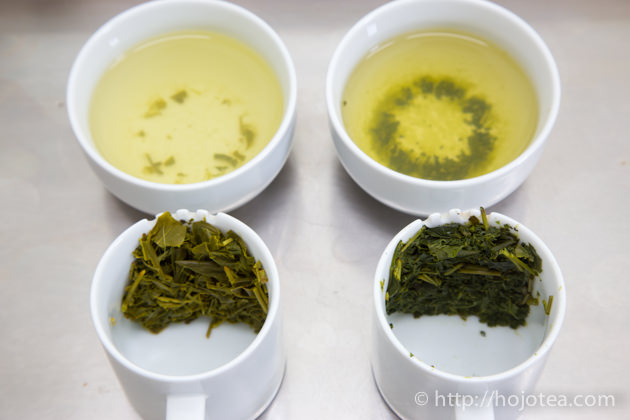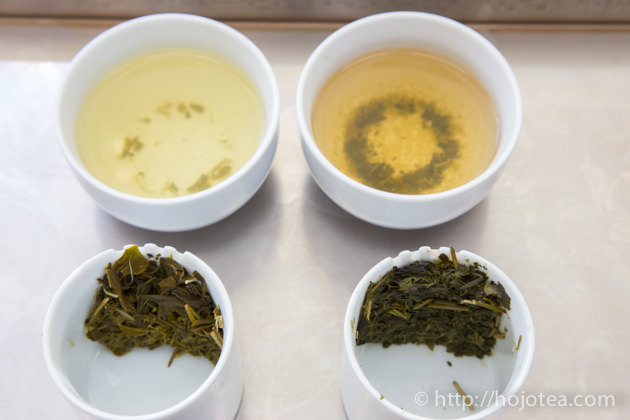- HOME >
- How to enjoy tea
Can we continue brewing tea next day after it’s been kept for a night?
- [2016.09.13] Posted By Akira Hojo

In brewing tea, sometimes we discontinue brewing after only one or two infusions. We often wonder whether we should continue brewing it. Sometimes we may think that the brewing style like gong-fu brewing style or traditional Chinese brewing style or even the type of teapot will determine the duration that the tealeaf can remained fresh up to several brewing. From my point of view, with the same brewing style, the type of tea is the key determinant of the duration that the quality remains fresh. In this context, the type of tea is referring to the way of growing tea and not the category of tea. Some people may think that the green tea doesn’t last long in brewing while pu-erh tea can last for long brewing duration. In this article, I focus on Japanese green tea as my study model to look into the factors that determine the duration of brewing.
The growing method affects the deterioration speed
Tea grown in common tea garden that uses nitrogen fertilizer (regardless of it is organic fertilizer or chemical fertilizer) is usually spoils faster. After brewing and being left for 24 hours, this type of tea tends to produce off-odor like raw garbage. However, the natural farming tea that is grown without fertilizer remains fresh even after keeping it for the same duration. The brewed leaf of the natural farming tea does not produce unpleasant smell after 24 hours. On the next day we can continue brewing it. The unpleasant flavor of those non-natural farming tea is not caused by the microbiological spoilage but the oxidation of amino acid. The richer the amino acid content in the tea, the faster it produces the off-flavor.
The relationship between fertilizer and nitrogen in tea
The amino acid content in tea varies a lot and it is depends on the way the tea tree is grown. According to the data from the quantitative analysis, the more nitrogen-based fertilizer it is applied, the more amino acid the tealeaf contains per unit area. On the contrary, the poly phenol content decreases in proportion to the application of nitrogen-based fertilizer. If tea is grown with no or less fertilizer, the poly phenol content increases.
Comparison between naturally farmed tea and fertilized tea
We selected two different types of Japanese green tea to run the experiment to observe the effect of fertilizer. The right one is produced in the common tea garden that uses plenty of nitrogen-based fertilizer. I could taste overwhelming level of umami (taste of amino acid). Another one on the left is the tea grown in natural farming method, using no fertilizer at all. Initially, right after the first brewing, the tea grown with fertilizer was vivid green color. ① Once the nitrogen fertilizer is being applied, ②the nitrogen is absorbed into tealeaf, ③ it grows faster, and ④ more chlorophyll is being synthesized in order to conduct more photosynthesis. This is the mechanism that the tea grown with fertilizer becomes vivid green.
Observation of the brewed tealeaf
The left is the naturally farmed tea and the right is the tea grown with fertilizer. The steaming of the tea on the right is slightly deeper. We choose tea that both contain stems so as to adjust the condition. As the characteristic of naturally farmed tea, it gives yellowish green even if it is fresh.

This photo was taken after 12 hours:The naturally farmed tea on the left was still giving very fresh-floral scent while the tea on the right losses its fresh flavor.

This photo was taken 24 hours later:The naturally farmed tea on the left was still giving very fresh floral scent while the one on the right was giving unpleasant flavor

This photo was taken 36 hours later:Tea becomes a little cloudy. It shows that some microorganism grows at this stage. To my surprise, the naturally farmed tea was still giving quite refreshing scent
On the first day, the tea grown with fertilizer was very vivid green. In 12 hours later, it lost the brightness and vividness in color and it turns brownish after 24 hours. On the contrary, the naturally farmed tea steadily remains yellowish color from the beginning until the end without causing brownish change. As for the aroma, the naturally farmed tea was giving floral aroma after 12 hours, yet the tea grown with fertilizer lost its fresh aroma. After 24 hours later, the naturally farmed tea was still giving floral aroma, although it was not as fresh as right after the brewing. As the tea grown with fertilizer, it was giving unpleasant odor like rotten vegetable.

The color of tea liquor after 24 hours later: The naturally farmed tea (left) did not change its color much, yet the tea grown with fertilizer turned brownish color.
Umami leads the deterioration of tea
Tealeaf that contains less free-amino acid can remain its freshness and floral scent for a long time, even if the brewed tealeaf is left for long hours. The reason why the tea grown with fertilizer produced the unpleasant flavor was due to the maillard reaction. The maillard reaction is the oxidation of amino acid and sugar. The amino acid that is called umami involves in this reaction. In Japanese, umami is referring to the taste of amino acid. In Japanese, umami also means delicious taste. Due to the confusion in this term, it often leads a misunderstanding that the more umami means more delicious. In fact, umami is nothing but a term to describe the taste of amino acid. Umami has nothing to do with deliciousness. For us, and for many tea lovers in China and Taiwan, the aftertaste defines the tea quality. The tea grown without fertilizer is rich in poly phenol. Such tea gives very long lasting aftertaste, and in addition, its freshness remained for a long time.
I often continue brewing tea if it is within 15-16 hours, and this is only for the naturally farmed tea. Regardless of the type of tea, the only type of tea that I can enjoy its fresh flavor after it has been left for a night is the naturally farmed tea. Relatively, the freshness of oolong tea could last for a longer time, even if it is not naturally farmed tea. Oolong teas are plucked in later timing (when tealeaf grown bigger). It contains less amino acid but more poly phenol. If you need to be away during brewing tea, one of the best practices that I would suggest is to keep the brewed tealeaf in refrigerator. Thanks to the lower temperature, the speed of oxidation is slower. We can enjoy its freshness for a longer time.
Related Articles
How to get the latest update on HOJO?
1. Follow Twitter, 2. Click "Like" on Facebook, and 3. Subscribe in newsletter. You can have the latest tea news from HOJO.
 Subscribe the Newsletter to enjoy the privileges
Subscribe the Newsletter to enjoy the privileges- You may receive a free sample upon purchase, or you may have the priority to purchase special products. So please remember to subscribe our newsletter as well as the social network.
- Myanmar White Tea Bud 2013 from Guo Gan, Myanmar
- We have released a raw Pu-erh tea, 緬甸白芽茶 2013 (Myanmar White Tea Bud 2013), produced by ethnic minorities in t …
- Yong De Wild White Tea 2025 Loose Leaf Limited Release
- We have released Yong De Wild White Tea Loose 2025. For the 2025 harvest, only the loose-leaf type was …
NEW ARTICLES
 Myanmar White Tea Bud 2013 from Guo Gan, Myanmar
Myanmar White Tea Bud 2013 from Guo Gan, Myanmar- We have released a raw Pu-erh tea, 緬甸白芽茶 2013 (Myanmar White Tea Bud 2013), produced by ethnic minorities in t …
 Yong De Wild White Tea 2025 Loose Leaf Limited Release
Yong De Wild White Tea 2025 Loose Leaf Limited Release- We have released Yong De Wild White Tea Loose 2025. For the 2025 harvest, only the loose-leaf type was …
 Experience the True Freshness of Raw Pu-erh : Tang Jia 2025 Loose Leaf Release
Experience the True Freshness of Raw Pu-erh : Tang Jia 2025 Loose Leaf Release- We have released Tang Jia Raw Pu-erh Tea 唐家古樹生茶 2025 Loose Leaf. Among HOJO’s raw pu-erh teas, Tang Jia Raw Pu …
 Yunnan Chun Jian Green Tea from High Mountain Gardens
Yunnan Chun Jian Green Tea from High Mountain Gardens- Yunnan Chun Jian Green Tea is now available. This tea is made from naturally grown leaves harvested from high …
 Limited Loose Leaf Release of 2025 Da Xue Shan Wild Raw Pu-erh Tea
Limited Loose Leaf Release of 2025 Da Xue Shan Wild Raw Pu-erh Tea- We have released the 2025 loose-leaf version of Da Xue Shan Wild Raw Pu-erh Tea. This tea comes from wild tea …
 Discover a New Way to Enjoy Tea: Cooking Rice with Tea
Discover a New Way to Enjoy Tea: Cooking Rice with Tea- Cooking rice with tea is a simple idea, but it brings surprisingly satisfying results. The tea’s flavour seeps …
 2025 Da Xue Shan Wild White Tea Now Available from Yunnan
2025 Da Xue Shan Wild White Tea Now Available from Yunnan- The 2025 harvest of Da Xue Shan Wild White Tea is now available. Crafted from truly wild Camellia taliensis tr …
 Fresh 2025 Yunnan White Tea – Select Your Favourite Lot Before Blending
Fresh 2025 Yunnan White Tea – Select Your Favourite Lot Before Blending- Freshly crafted in Yunnan and just arrived in KL, our new 2025 white tea is now available at our Gardens Mall …
 2024 Dong Shan Raw Pu-erh Tea – Crafted with the Producer for Desired Quality
2024 Dong Shan Raw Pu-erh Tea – Crafted with the Producer for Desired Quality- We have released the 2024 cake of Dong Shan Raw Pu-erh Tea. Earlier, we offered the loose-leaf version from th …
 Development of Firewood Roasted Hojicha Using Naturally Grown Tea from Yunnan
Development of Firewood Roasted Hojicha Using Naturally Grown Tea from Yunnan- We are currently staying in Yunnan Province for tea production. As the season nears its end, tea trees with pa …
Category
- New Arrival at HOJO Online Shop
- Featured Articles
- Newsletter
- Types of Tea
- Origin of Tea
- Teapot and Tea Equipment
- Tea Column
- How to enjoy tea
- Tea Processing
- How to choose quality tea
- Tea constituents and functional effect
- Safety of Tea
- Foods
- Tea Business Operation
- Hobby and Outdoor Activity
- Ranking of Tea
- Video
- FAQ
- Media Release
Profile

- AKIRA HOJO
- I invite you to experience my tea selections.I was born in Nagano, Japan. In university, I studied agricultural chemistry, and I have the master degree in food science. I worked in Japanese food industry for 10 years. I involved in R&D, QC and QA. As a factory manager, I implemented ISO9000 series and managed the factory.
- The Art of Tea Magazine
- We posted the article on “The Art of Tea Magazine No.9, the magazine is published in Taiwan. We featured …
- New Straits Times
- The Malaysian National Newspaper, New Straits Times featured HOJO Tea on 17-Oct-2007.
Shop Info

Address:Lot No. T-215, 3rd Floor, The Gardens Mall, Mid Valley City, Lingkaran Syed Putra, 59200 Kuala Lumpur
Tel: +603-2287-4537
Business Hour: 10am to 10pm
















